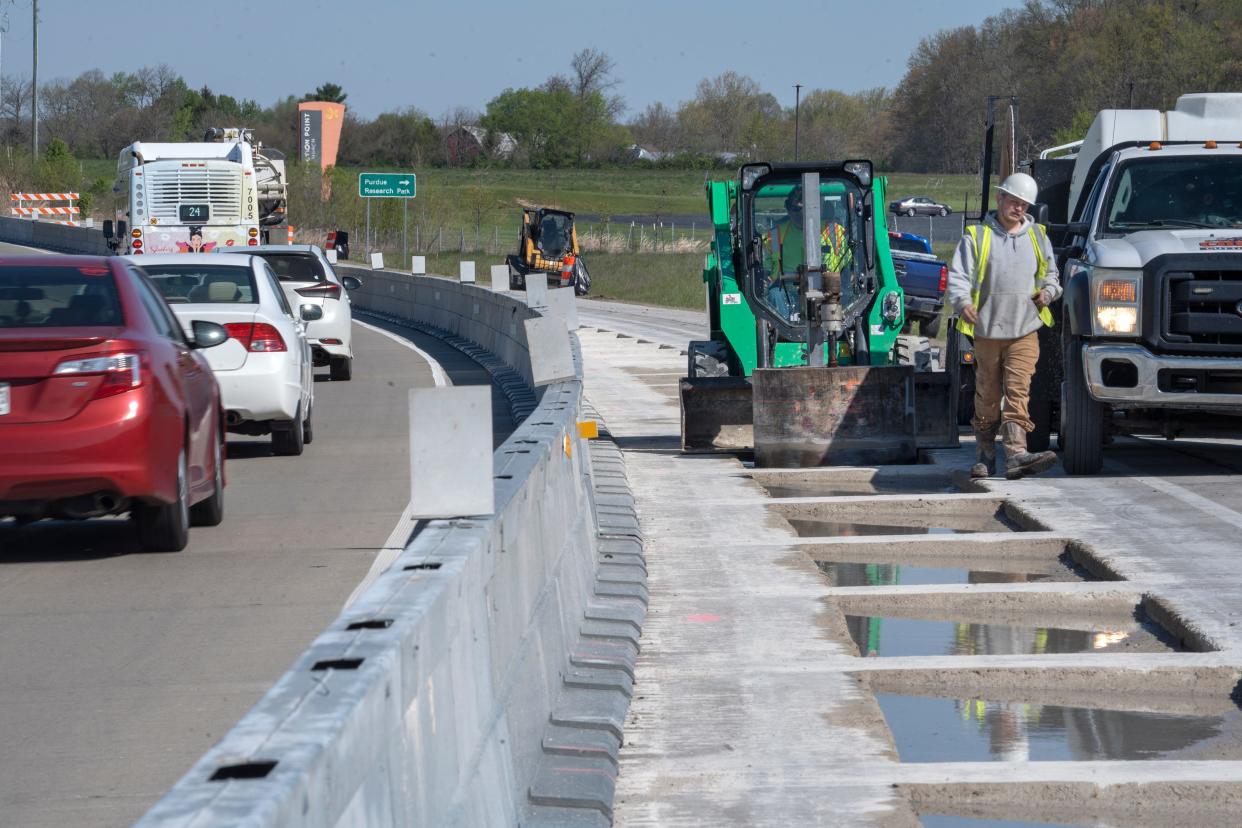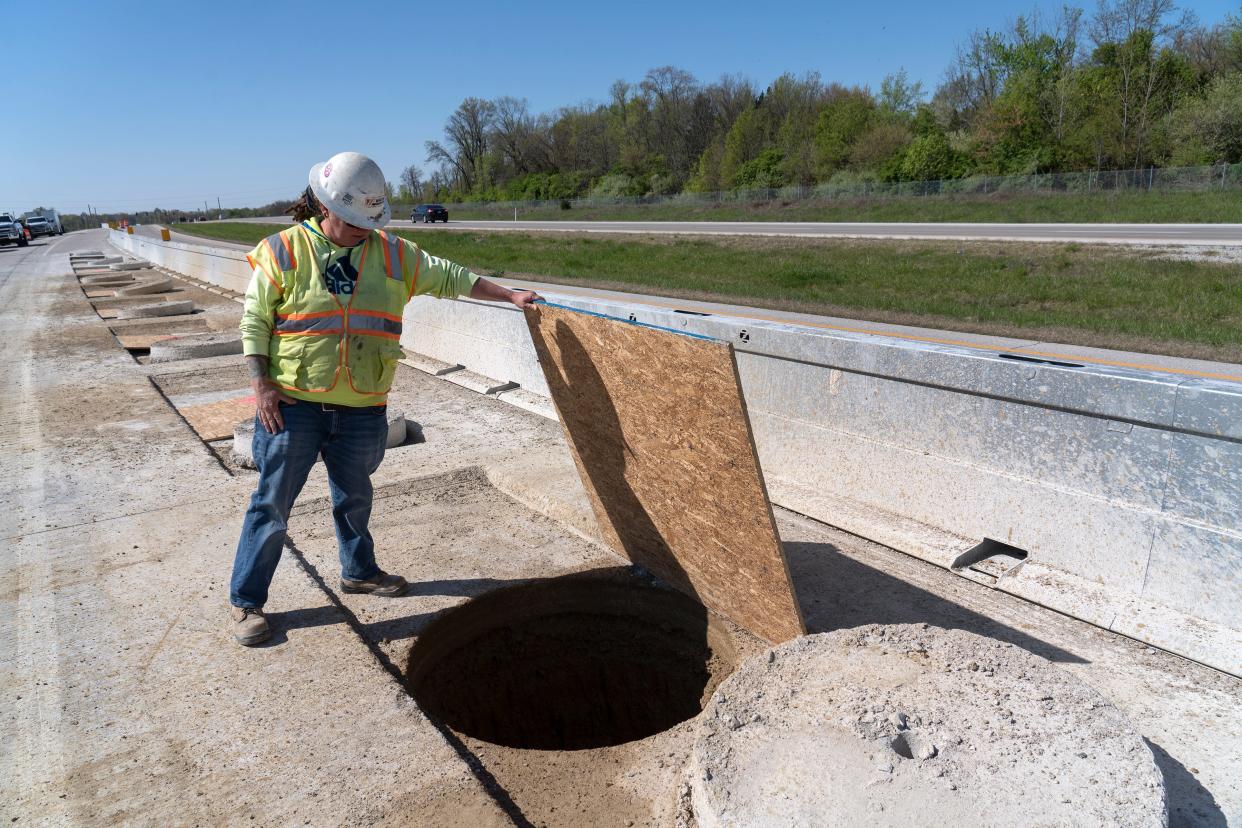Indiana wants to charge your electric vehicle while you drive. But is it actually possible?
A quarter-mile stretch of state highway in West Lafayette, Indiana, could help shape the future of electric vehicles in the U.S. and around the world.
That’s where the Indiana Department of Transportation and Purdue University plan to test a patent-pending system designed to provide power to heavy-duty electric trucks traveling at highway speeds. Construction work on the pilot project, based on research by university engineers, began April 1.
The technology is like a product many people already use on a daily basis: magnetic cellphone charging pads. The process behind both is called electromagnetic induction, but the major difference with vehicles is the amount of power needed and the distance between the charger and bottom of the vehicle.
Supporters say the Indiana project has the potential to open new opportunities for electric vehicles, addressing the huge barrier created by battery limits, while helping reduce air pollution. Transportation is the largest single source of greenhouse gasses, making up nearly one-third of the country’s carbon footprint, according to the U.S. Environmental Protection Agency. Heavy-duty trucks are one of the biggest sources within the transportation sector, spewing particulate matter pollution that can have a long list of negative health impacts.
In a state such as Indiana — known as the "Crossroads of America" with significant truck and passenger traffic passing through — this technology could mean big gains for air quality.
But don’t count on a major transformation anytime soon. Building a prototype truck and small-scale charging roadbed will be much easier than rebuilding thousands of miles of powered roads and adapting EV technology. Still, many eyes will be on Indiana to see if the technology is scalable for widespread use.
Indiana’s project isn’t the first wireless EV charger in the nation. Late last year, a similar pilot was installed on a residential street in Detroit. Making the technology possible for highways and heavy-duty trucks, however, is a first — and an unusual hurdle. The faster highway speeds require significantly more power, upwards of 200 kilowatts of power transferred across a distance of 10 to 12 inches, according to Kayla Albert at Purdue.
“This power level is the average power consumed by 100 homes,” she said. “This is the amount of power needed to propel a heavy-duty truck moving at 65 mph.”
For the pilot project, the power will come from a portable diesel generator, which Albert said is sufficient for the single test truck when it drives over the road. That prototype is being built by Cummins, Inc., an Indiana diesel engine manufacturer that also is a partner in the project.
Potential large-scale use of the technology would require drawing power from the grid.
Given their size and the long journeys they make, large trucks are one of the most challenging parts of the transportation sector to decarbonize. They need a significant amount of fuel, and an equivalent battery is extremely heavy and takes a long time to charge. With Purdue's technology, however, rather than charging the vehicle battery in the traditional sense, electricity transferred from the road powers the moving vehicle, going straight to the wheels.
Enabling trucks to receive power while driving would reduce the need for a large amount of onboard battery capacity, according to Cummins, thus reducing weight, cost and concerns over the range of the vehicle.
EV Charging: How a highway could power heavy-duty electric vehicles
The design also will support the lower power required for passenger cars — there were 24,000 EVs registered in Indiana in 2023. Officials hope that such technology could spur great adoption of EVs across all vehicle classes, and ultimately redefine the way people think about them.
Still, the question of feasibility looms large.
Existing roads would need to be ripped up and rebuilt with the transmitter coils and other necessary equipment. That means a lot of construction and a huge price tag. The pilot project in West Lafayette — just a quarter-mile segment — will take close to a year before it's ready to go and cost roughly $11 million alone, according to INDOT.

Purdue's researchers said they don't envision 100% of roads being electrified. Rather, the powered pavement would need to be strategically implemented to support transit routes and to complement the expanding network of EV charging ports.
Electric vehicles as they exist today also would need to be revamped to receive the charge. That includes installing different receptor coils to take in the power as they move. While not many electric heavy-duty trucks exist and can be manufactured this way from the get-go, EVs already on the road would essentially need to be redesigned.
A payment system would also need to be devised to measure the power a vehicle consumes while driving.
'Good pandemonium': Indiana races toward plans for a new era of electric vehicles
Given these obstacles, researchers from Purdue anticipate that it may be as many as 20 to 30 years before EVs can receive the full power they need while driving at highway speeds. Still, the team said it hopes the pilot project will convince the industry that electrified highways could work.
This comes at a time that Indiana is seeing a record investment in electric vehicle production from the industry. Federal regulations also are putting pressure on automakers to make significant cuts to tailpipe emissions.
"If dynamic wireless power transfer can be shown to be economically and technically viable," said Tim Frazier, vice president of research and technology at Cummins, Inc., "it could be a game-changer."

Call IndyStar reporter Sarah Bowman at 317-444-6129 or email at sarah.bowman@indystar.com. Follow her on Twitter and Facebook: @IndyStarSarah. Connect with IndyStar’s environmental reporters: Join The Scrub on Facebook.
IndyStar's environmental reporting project is made possible through the generous support of the nonprofit Nina Mason Pulliam Charitable Trust.
This article originally appeared on Indianapolis Star: The future of EVs could come down to this charging project in Indiana
